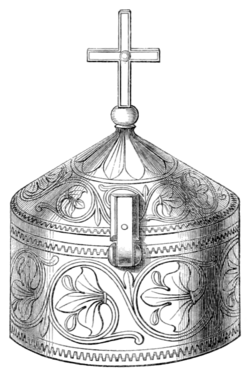The Abbé Texier, whose learned Historical Essay on the Artists of Limoges affords the most valuable information hitherto published on the subject of Enamel[1], supposes that the art was introduced from Constantinople into France by way of Venice, towards the close of the tenth century. The artificers of Limoges appear to have excelled in the art of enamelling, and during a long series of years their productions were highly esteemed in many countries of Europe. A document dated A.D. 1197, shews that even in Italy their works were not unknown[2]. Of the esteem in which they were held in England a curious evidence is supplied by the Constitutions of the bishops of Worcester, Walter de Bleys, A.D. 1229, and Walter de Cantilupe, A.D. 1240, respecting the ornaments and vessels to be provided for every parish church, in which it was ordained that the Eucharist should be reserved in a pyx formed either of silver, or ivory, or of the work of Limoges, "de opere Lemovitico[3]." Dr. Rock possesses a pyx of this period which had been used for that purpose in a parish church in Buckinghamshire, as he has reason to believe, previously to the Reformation. Of precisely similar form is the pyx in the possession of Mr. S. P. Cox, of which a representation is given. The field is partly of an intense blue colour, produced probably by cobalt: a pale green being
- ↑ Mémoires de la Société des Antiquaires de l'Ouest; Poitiers, 1842, p. 101.
- ↑ The following item occurs in a charter of that date, cited by Ughelini, Italia Sacra, VII. 1274. "Duas tabulas æneas super auratas de labore Limogie."
- ↑ Wilkins's Conc. i. pp. 623, 666. In the visitation book of William, dean of Salisbury, A.D. 1220, it is stated that at Wokingham, Berkshire, there was found "crux processionalis de opere Lemovicensi," and in the chapel of Hurst, in the same county, "pixis dependens super altare cum Eucharistiâ, de opere Levomicensi," (sic). Amongst the feretra, or shrines in St. Paul's, A.D. 1298, are enumerated "duo coffræ rubeæ de opere Lemovicensi," as likewise candlesticks of copper and a cross, "de opere Limoceno." Dugd. Mon. iii. 31. Amongst the gifts of Gilbert de Glanville, bishop of Rochester, 1185—1214,are enumerated "cofres de Limoges." Reg. Roff. 121. Prior Helyas gave also to Rochester cathedral "bacinos de Limoges, qui sunt cotidie ad majus altare."

